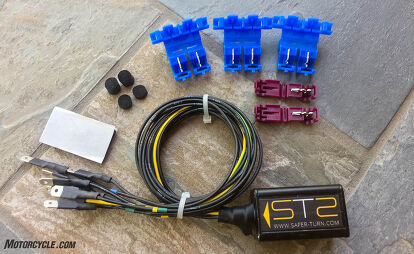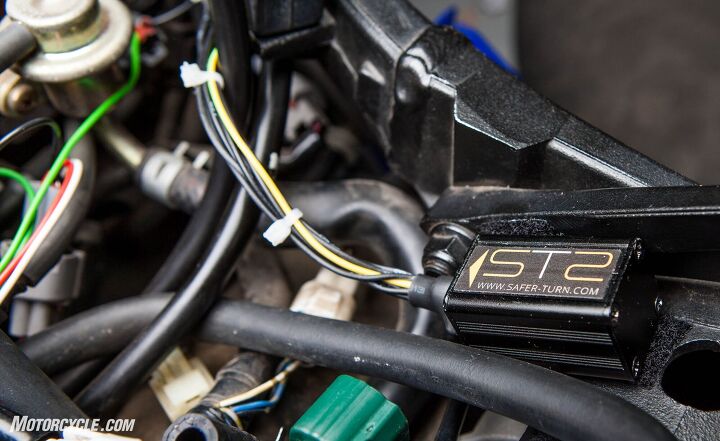MO Tested: Smart Turn System Self-Canceling Signals

Intelligent self-canceling turn signals
For years, I’ve claimed that self-canceling turn signals were the answer to a question I never asked. I’d yet to experience an automated system that didn’t introduce one or more problems or adaptations I had to make in order to utilize turn signals the way I preferred to use them. Some systems turned the signals off too soon while others kept them on for an eternity, but both forced me to take my eyes off the road to check if the signals were on or off before and after a turn.
When I was asked by E-i-C Duke to test the Smart Turn System, I said I was willing, but I fully expected to dislike the Smart Turn System and remove the unit from my bike once the test was complete. Well, it’s time for me to eat a little crow and say up front that the little black box I installed on my personal R6 is going to stay.
The Smart Turn System (STS) is just a little black box, measuring roughly 0.9 in. x 1.0 in. x 1.75 in., that gets spliced into a bike’s wiring harness. Fortunately, the splices are in the wiring that connects the turn signal switch on the left grip to the main harness, meaning that if you butcher the job the only system on your bike that will be affected is the turn signal. Like many (perhaps most) people, I am loath to cut the main harness of my motorcycle unless it is absolutely necessary.
The kit itself is remarkably simple, consisting of the STS unit with its 10-inch wiring, three wire splices, two wire taps, four foam spacers, and a piece of hook-and-loop tape. The real work of the installation is uncovering the correct wire harness. Although my R6 required that the tank and the airbox be removed to give the harness enough slack to splice into the individual wires, I suspect that many bikes will be much easier to expose the correct wiring.
Since this is a modification of a system that was designed for manually resetting the signal, the first step is preventing the turn-signal switch from latching in the on position and requiring the button to be pressed to reset the switch. So, I spent a mere 10 minutes opening the left grip’s switch housing and inserting a pair of soft foam pads into the switch. These pads allow for the switch to make an electrical connection while preventing the switch itself from locking in the on position. Once the STS is completely installed, it receives the brief power signal from either the left or right side of the turn-signal switch and then the STS itself handles the switching duties.
When I initially opened the STS package, I was distressed to see the clip-on-type wire connections. In the past, I’ve spent many hours chasing intermittent electrical issues caused by a loose clip-on wire tap. Still, I decided to use the taps on this install for a few reasons. First, I think I should follow the manufacturer’s instructions to completely test a product. Second, many people are not comfortable with soldering connections – even though it is really easy. Finally, since I expected to hate the STS, I figured that I’d be removing it after writing my highly critical review, and unclipping the connectors would be much cleaner than unsoldering the STS wires before resoldering the places where I’d clipped the harness wires.
Although the directions and the wire listing specific to my bike were very clear (with one mistake), I highly recommend having the factory service manual with you when you perform this installation. That way, if something goes wrong – as it did with my install – you’ll have the factory wiring diagram to troubleshoot your issue. In my case, the wrong wire was listed as the one to get the switched 12V power for the STS. The wire on my instructions was for the high beam and not the headlight itself. This meant that the STS would not function unless the high beam was powered. When I discovered that the STS didn’t work, basic troubleshooting with my multimeter pointed out that the unit was not getting any power, and a quick trip to the wiring diagram pointed out the problem. Time lost: about an hour.
Once that glitch was sorted out, the STS worked like a charm. After a quick set up that involved turning each signal on for 30 seconds and then manually turning them off, I set out to see how the STS worked on the street. Before I’d gotten to the end of my block, I’d tested the lane change signal cancel. Pass. At the end of the block, I sat for a couple minutes with the signal flashing away. Pass. As soon as I turned right from a stop, the signal flashed one more time and then canceled. Pass. I tried every combination of braking and turning I could think of, and the STS correctly canceled the signal every time.
The only way I was ever able to trick the STS was pulling into my driveway. Because it is steep and narrow, I swing wide into the left lane to make my approach after turning right into the driveway as straight as possible. The STS canceled the right turn signal after the swing to the left. However, this is such a minor – and quite esoteric – issue that I almost didn’t include it in my review.
The other small quibble I have with the STS is that my right turn signal required a slightly harder press to get the signal to activate. Since the switch has a foam pad inside it, I had to spend 10 minutes opening the switch up and trimming the pad slightly. Not a big deal at all. Additionally, now that I intend to keep the STS installed on my R6, I plan on redoing the wiring with soldered connections. While many riders may be fine with the clip-on splices, they just bug me – though not enough to get out my soldering iron and do it before this story was due. It’s a project for another day.
The Smart Turn Signal has converted me from someone who didn’t like self-canceling turn signals into someone who thinks that this implementation is a pretty cool idea – self-canceling turn signals the way the OEMs should have done them in the first place. The STS retails for 149€ ($167) can be ordered direct from the manufacturer in Slovenia at www.safer-turn.com.

Like most of the best happenings in his life, Evans stumbled into his motojournalism career. While on his way to a planned life in academia, he applied for a job at a motorcycle magazine, thinking he’d get the opportunity to write some freelance articles. Instead, he was offered a full-time job in which he discovered he could actually get paid to ride other people’s motorcycles – and he’s never looked back. Over the 25 years he’s been in the motorcycle industry, Evans has written two books, 101 Sportbike Performance Projects and How to Modify Your Metric Cruiser, and has ridden just about every production motorcycle manufactured. Evans has a deep love of motorcycles and believes they are a force for good in the world.
More by Evans Brasfield





































Comments
Join the conversation
As you said in your introduction, self-canceling turn signals are the answer to a question I didn't ask. They are useless. They add one more thing to break. I have had to replace the self-canceler on two cars. This required pulling the steering wheel. Both were before the steering wheel hubs were equipped with a bomb aimed at me.
If it had only been the self-canceling function that quit working, I'd have said good riddance but on one the turn signals wouldn't work at all and on the other the turn signal wouldn't stay on unless I held it ‘on.’
Way back in prehistoric times I had a ’60 MGA. It had a knob on the dashboard that I turned a quarter turn either way. It had a timer that turned the flasher off according to how far the knob was turned.
For years I drove Citroën cars. Their turn signals stayed ‘on’ until I flipped the stalk back to center (‘off’). Pull the stalk back a little to beep the horn, farther to blow the air horns. Push the stalk forward to flash the high beams (disabled on USA models - illegal back then).
Just had the system installed on my Moto Guzzi V7 II at the shop. Does seem that I have to press harder on the switch for a right turn.